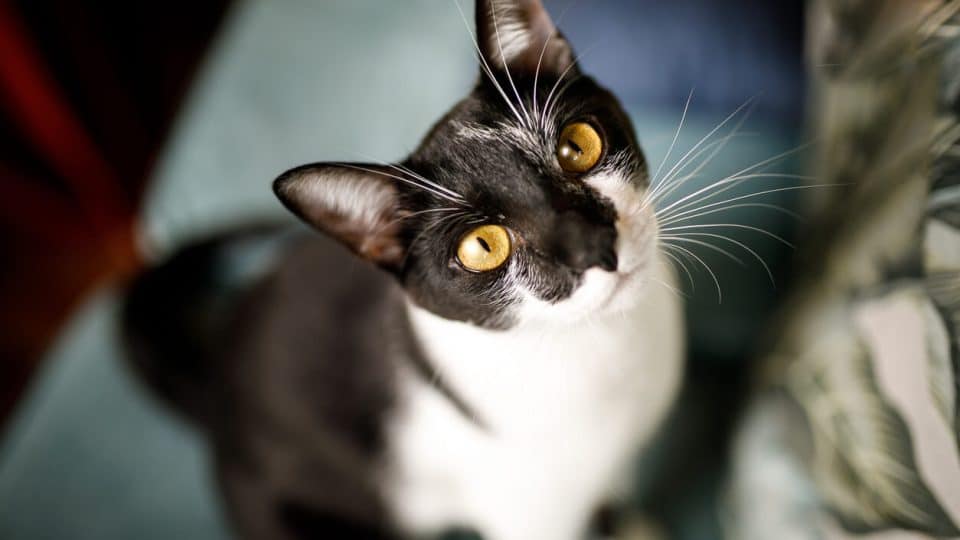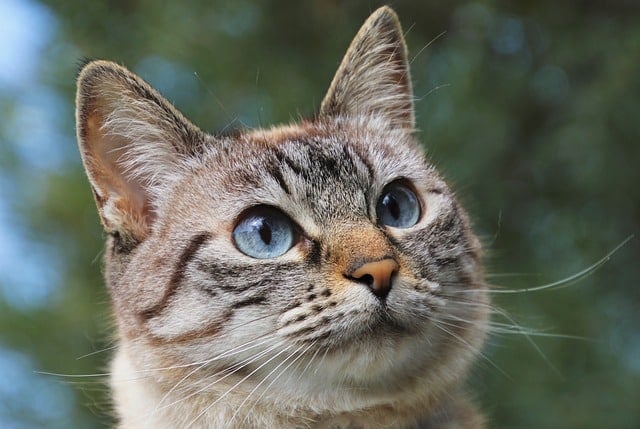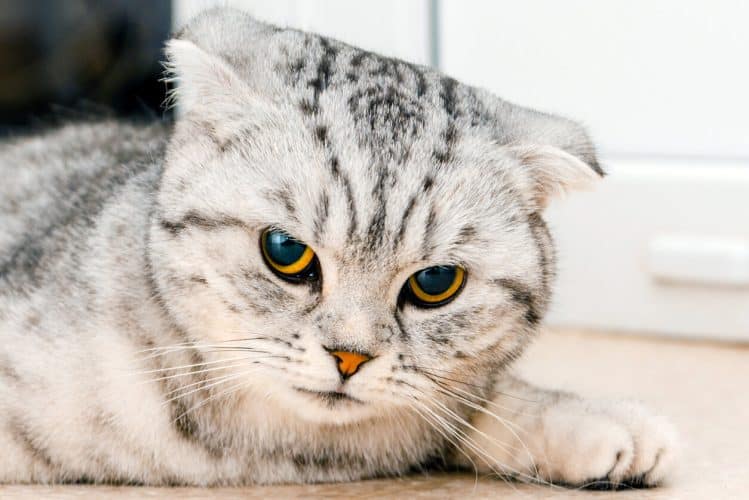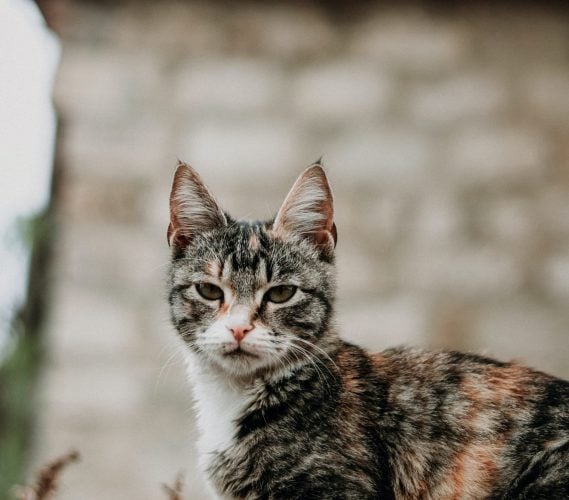- Not a substitute for professional veterinary help.
Cats aren’t exactly known for being open books. Still, they do have plenty of ways to share their emotions and needs, from vocalizations to body language like meows and head butts. A cat’s eyes can also tell you a lot about their health and how they’re feeling.
The eyes are a pathway of direct communication, says Stephen Quandt, Certified Feline Behaviorist and founder of Feline Behavior Associates. Since cats have pupils with vertical slits, their eyes allow for a much wider pupil size and shape than humans have—and more size equals more expression, Quandt says.
Knowing how to decipher the meaning of your cat’s eyes can help you better understand your cat, which makes it easier to meet their needs and build a stronger bond.
How Do We Know What A Cat’s Eyes Mean?
A cat’s eyes can communicate a wide range of emotions, including fear, excitement, anger, trust, and affection.
Of course, it’s important to look at a cat’s eyes in context, Quandt says. For instance, dilated pupils can point to excitement or fear, so the meaning may depend on whether your cat is breaking in a brand-new toy or you just pulled the vacuum cleaner out of the closet. Your cat’s pupils may also dilate in lower light.
Along with pupil dilation, you’ll also want to consider body language cues like ears, whiskers, and tail position, as well as vocalizations.
Below, find six common cat eye behaviors, plus their meanings.
The Slow Blink Of Love
The slow blink, sometimes called a cat smile, is one way cats convey affection and trust. This positive form of communication involves half-closed, relaxed eyes. It gives the appearance of vulnerability, so you can take it to mean your cat feels safe and comfortable with you, according to Quandt.
“A cat worried about a threat won’t close their eyes in the face of that threat, even briefly,” Quandt says.
If you pay attention to your cat’s body language as they slow blink, you might notice other signs of contentment, like:
- Purring
- Upright ears
- Sitting nearby or on you
- Lying down or in a loaf position
- Kneading
- A slowly swishing tail, or a tail pointed up and curled like a question mark
One of the best ways you can respond to a slow blink from your cat? Slow blinking right back at them! Evidence suggests cats perceive your slow blinks as positive and are likely to respond to them. In fact, some experts believe this behavior remains so common because people tend to reinforce it.
Plus, communicating with your cat in one of their “love languages” could go a long way toward strengthening your bond.
Half-Closed Happy Times
Cats also use their eyelids to communicate. If you catch them gazing at you with heavy-lidded, half-closed eyes, they’re likely feeling happy, peaceful, and relaxed.
“A cozy cat who is at peace, perhaps lying in the sun, may appear to partially close their eyes as a sign of contentment or impending sleep,” Quandt says.
If you’ve just returned home, you might also notice this eye behavior when they greet you.
Some other signs of a happy cat include:
- High-pitched meows, purring, and trilling
- Upright, forward-facing ears
- Head butting or rubbing against you
- An upright tail, a softly swishing tail, or an upright tail curled at the top like a question mark
- Lying down in loaf position or showing their belly
To keep your cat happy, try whipping out their favorite toy, whether that’s a wand or a catnip mouse. You can also try offering your lap (or shoulder!) for cuddles.
The Hard Stare
As many pet parents know firsthand, cats are prone to staring—at you, the walls, their partially empty bowl of food. And like many other cat behaviors, staring can mean plenty of different things.
“A cat who is staring may be feeling aggressive, but you have to look at what else is going on with the cat before assuming that,” says Dr. Mikel Delgado, Certified Cat Behavior Consultant, founder of Feline Minds, and Rover’s resident cat expert.
Unlike a soft stare (which might just mean your cat wants something from you) extended eye contact with few blinks can suggest dominance, aggression, or discomfort, according to the team at Harpeth Hills Animal Hospital. You might, for example, be invading your cat’s personal space or making them uncomfortable in some way.
Other signs of an irritated cat include:
- Growling or hissing
- A lashing tail
- Pinned or flattened ears
- Puffed hair
- Tensed body with arched back
If you encounter a hard stare from your cat, Amanda Caron, Cat Behaviorist, IAABC Shelter Behavior Affiliate, and founder of Frisky Feline Behavior Counseling, suggests avoiding looking directly into their eyes. They may take a deep stare as a threat, especially if they already feel nervous or afraid. Instead, offer some soft blinks to soften your gaze and help them feel calmer.
Does your cat frequently stare at you with an unrelenting gaze and signs of anger? Caron recommends considering the whole picture to learn more about their needs. Did something just happen that could have triggered irritation or distress?
Full Alert: Wide Eyes And Dilated Pupils
Wide eyes with dilated pupils are a hallmark sign an alert and engaged cat. You’ll notice your cat’s eyes appear round, with their eyelids up, but you’ll still be able to see some of the colored iris.
“Pupils can dilate when a cat is excited or afraid,” Delgado says. “It’s basically their brain saying ‘get more information’ from the environment.”
Quandt says their posture can offer more details. For instance, a body crouched low, with a raised rear and low tail, can point to a play or serious attack.
You might also notice them in this posture with constricted pupils. This is because a cat’s pupils will enlarge or narrow depending on how they need to hone in on distant objects, according to Quandt.
Other signs of an alert and curious cat:
- Upright ears that point forward or slightly to the side
- Forward-facing whiskers
- Trilling, chirping, or meowing
- Upright tail with a curved tip, or tail held level with their back
- High head position
Overstimulated Saucer Eyes
Your cat’s massive, nearly-black pupils may look adorable, but these cat eyes mean it’s time for a break from snuggling. This pupil expression is a clear sign of overstimulation or anxiety.
“A cat experiencing this level of stress is likely to have a heightened response because fight or flight mode is setting in,” Caron says.
Cats are very sensitive creatures when it comes to human touch, and some of them reach their limit quickly. If you keep petting them, they may scratch or bite!
It can help to keep petting sessions short—let your cat determine the length and stop petting once they move away. You’ll also want to avoid petting cats on certain “hot spots,” like their belly or tail. Of course, this can vary from cat to cat, but your cat will absolutely let you know!
Anxiety can also cause this pupil expression. Other signs of anxiety in cats include:
- Crouching and hunkering down low to the ground
- Trembling or shaking
- Excessive meowing, crying, or shrieking
- Hissing or growling
- Tail flicking or fluffed hair
- A tail tightly wrapped around a crouched body
- Flattened or sideways ears
- Rapid and excessive grooming
- Fleeing and hiding hiding
It’s not always easy to pinpoint a cat’s anxiety triggers, especially if nothing out of the ordinary happened to alert you. But it can always help to give your cat space. Rushing to comfort them could add to their stress.
If your cat often seems anxious and their eyes frequently take on a “saucer” appearance, it never hurts to check in with your vet. They can help rule out any medical concerns that might play a role in your cat’s distress.
Another option involves making your home more soothing by:
- Plugging in cat-calming pheromone diffusers
- Trying cat calming collars or ThunderShirts
- Offering more mental stimulation, from puzzle feeders to hanging bird feeders outside windows
- Setting up motion-activated or battery-operated interactive toys
Narrowed Slits Mean Business
If you’ve ever encountered a cat basking in the sun, you’ve likely seen just how narrow their pupils can get.
But it’s not always fun in the sun when you catch your cat with narrowed pupils. If a cat’s pupils become thin slits when they’re not in a bright environment, they’re generally angry or ready to attack. You might also notice their eyes seem squinted or half-closed.
“Squinting eyelids with contracted pupils at the same time is usually a strong warning signal,” Quandt says, adding that a quickly contracting pupil means the cat may be focusing on (and ready to attack!) something they consider prey.
Other key signs of a pre-combat aggressive stance include:
- Ears that are upright, pointed back, or flattened against the head
- Hard, direct staring
- Growling, yowling, hissing, and spitting
- Fur bristling and hackles raised
- A twitching, thumping, thrashing, or very stiff tail
- Crouched position or stiff and tense body
- Bared teeth
Can Changes In Your Cat’s Eyes Mean They Have A Health Problem?
Cats tend to hide pain and illnesses, an evolutionary trait that helps keep them safe from predators. But their eyes can offer some clues to their health as well as their mood.
“The size of the pupil is also a function of the amount of light present and sometimes indicates the health of the cat,” Quandt says. “Unevenly sized pupils, or pupils that don’t contract when exposed to light, may indicate a medication condition, and a prompt vet visit is in order.”
Anisocoria
Cats with the ophthalmological disorder anisocoria have uneven pupil sizes, with one pupil larger than the other. Causes of anisocoria include glaucoma, seizures, and head trauma.
This condition can also be a sign of severe or life-threatening health conditions, including:
- Eye cancer
- Brain tumors
- Feline immunodeficiency virus
- Feline leukemia
- Parasitic infections like toxoplasmosis
If you notice one of your cat’s pupils is dilated and the other isn’t, contact your vet right away. Emergency veterinary care may help prevent or delay blindness.
Other cat eye problems
A cat who keeps squinting may have an eye issue that’s causing pain and discomfort, including these health conditions:
- Feline conjunctivitis
- Keratoconjunctivitis sicca, or “dry eye”
- Feline glaucoma
- Corneal ulcers
- Blepharitis
- Allergies
- Bacterial or viral infections
Signs to pay attention to
You’ll want to contact your vet if your cat seems to paw and rub at their eyes more than usual, or you notice they have:
- Reddened, pink, or bloodshot eyes
- Squinting or swollen eyes
- Runny discharge
- Uneven pupil sizes
- Watery eyes
- Coughing, sneezing, and wheezing
- An inflamed third eyelid
- Itchy skin and rash
- Digestive system upset, like gas, vomiting, diarrhea
- Dull or cloudy eyes
- Less energy or seems fatigued and lethargic
If you can’t reach your vet and your cat has red eyes with discharge, you may want to call your local 24-hour vet for more guidance. They may suggest bringing your cat in right away.
How Can You Tell If A Cat Has Vision Problems?
In some cases, cats may develop vision problems with no outward signs of redness, discharge, or changes in pupil size.
You may notice, however, that they:
- Trip or fall when climbing stairs
- Bump into furniture or walls
- Act more fearful and cautious
- Spend more time in their favorite hiding places
- Have less interest in playing
- Struggle to find their food bowl and litter box
- Walk in a crouched position
- Can no longer jump or climb easily, if at all
Even if your cat’s eyes seem perfectly fine, these signs may point to vision loss. Your vet can examine your cat’s eyes carefully and help determine the cause.
If your cat does lose their sight, know they can absolutely still have a full and happy life! Even if they can’t see you, don’t be surprised if they come running at the sound of your voice.





